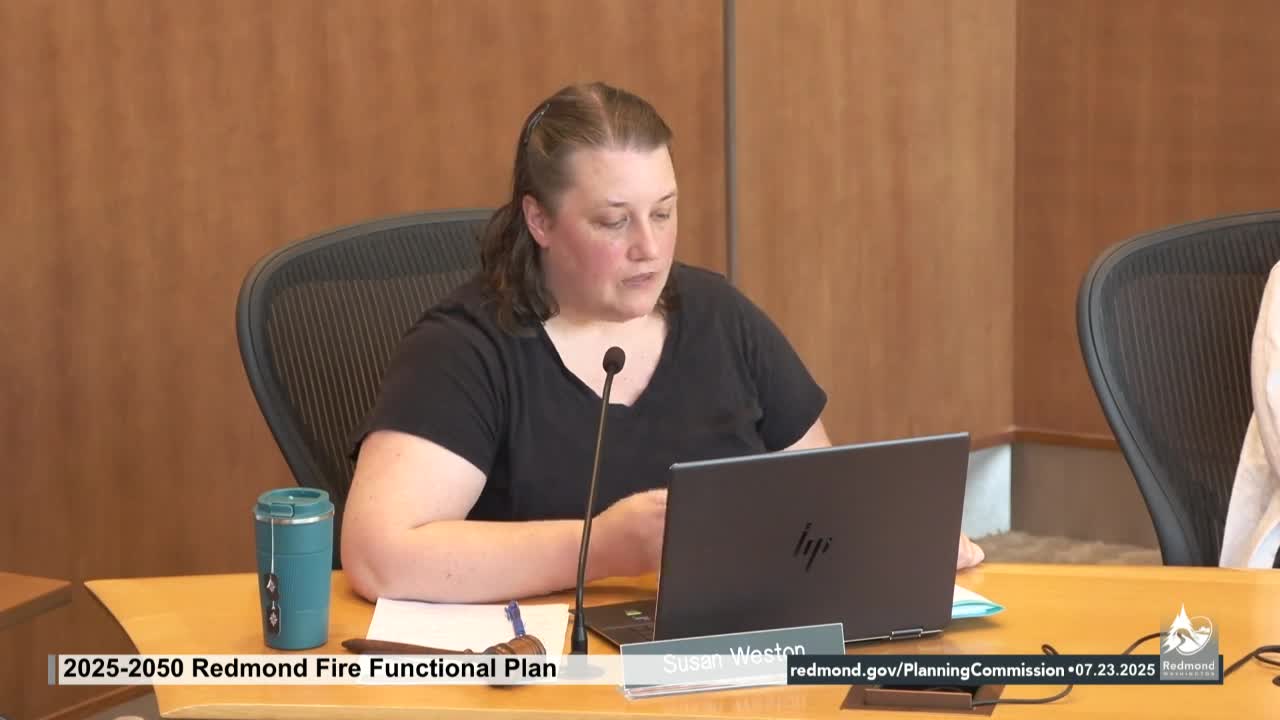Redmond Fire Department Reviews Service Levels Amid Urban Growth and Infrastructure Needs
July 23, 2025 | Redmond, King County, Washington
This article was created by AI summarizing key points discussed. AI makes mistakes, so for full details and context, please refer to the video of the full meeting. Please report any errors so we can fix them. Report an error »

In the heart of Redmond's city hall, a pivotal discussion unfolded on July 23, 2025, as the Planning Commission delved into the future of the city's fire services amid rapid growth. The atmosphere was charged with anticipation as officials and community members gathered to address the pressing need for a strategic overhaul of the fire department's infrastructure and response capabilities.
A key concern raised during the meeting was the adequacy of the current fire service model, which some described as a relic of the 1970s and 1980s. As Redmond's population continues to swell, the existing system, while operationally sound, struggles to keep pace with the demands of a more urbanized environment. The conversation highlighted the necessity of not just incremental improvements but a comprehensive reevaluation of how fire services are delivered in a city poised for significant growth.
The fire chief took the floor to clarify the department's approach to measuring service levels. He emphasized that the community's expectations shape these standards, which extend beyond mere response times to include critical outcomes like fire prevention and community safety. The chief acknowledged that while the current infrastructure is well-managed, it is increasingly challenged by the city's expansion, particularly in areas with taller buildings that require different firefighting strategies.
As the discussion progressed, the need for a capital facilities plan became evident. This plan aims to identify the most cost-effective improvements necessary to enhance service delivery, including potential relocations of fire stations to better serve the community. The chief noted that while Redmond's population is around 80,000, the department also serves neighboring areas, effectively raising the service demand to approximately 110,000.
The commission explored the implications of future developments, particularly in the Overlake area, where high-rise buildings are anticipated. The chief assured attendees that the plan includes provisions for moving and adding fire stations to ensure that response times remain efficient, even as the city evolves. He pointed out that the plan's appendices detail the modeling used to predict service needs in growing neighborhoods, ensuring that the fire department is prepared for the challenges ahead.
In conclusion, the meeting underscored a critical juncture for Redmond's fire services. As the city looks toward its 2050 growth plan, the discussions revealed a commitment to not only maintaining but enhancing the level of service provided to residents. The path forward will require thoughtful planning, community engagement, and a willingness to adapt to the changing landscape of urban living. The decisions made today will shape the safety and resilience of Redmond for generations to come.
A key concern raised during the meeting was the adequacy of the current fire service model, which some described as a relic of the 1970s and 1980s. As Redmond's population continues to swell, the existing system, while operationally sound, struggles to keep pace with the demands of a more urbanized environment. The conversation highlighted the necessity of not just incremental improvements but a comprehensive reevaluation of how fire services are delivered in a city poised for significant growth.
The fire chief took the floor to clarify the department's approach to measuring service levels. He emphasized that the community's expectations shape these standards, which extend beyond mere response times to include critical outcomes like fire prevention and community safety. The chief acknowledged that while the current infrastructure is well-managed, it is increasingly challenged by the city's expansion, particularly in areas with taller buildings that require different firefighting strategies.
As the discussion progressed, the need for a capital facilities plan became evident. This plan aims to identify the most cost-effective improvements necessary to enhance service delivery, including potential relocations of fire stations to better serve the community. The chief noted that while Redmond's population is around 80,000, the department also serves neighboring areas, effectively raising the service demand to approximately 110,000.
The commission explored the implications of future developments, particularly in the Overlake area, where high-rise buildings are anticipated. The chief assured attendees that the plan includes provisions for moving and adding fire stations to ensure that response times remain efficient, even as the city evolves. He pointed out that the plan's appendices detail the modeling used to predict service needs in growing neighborhoods, ensuring that the fire department is prepared for the challenges ahead.
In conclusion, the meeting underscored a critical juncture for Redmond's fire services. As the city looks toward its 2050 growth plan, the discussions revealed a commitment to not only maintaining but enhancing the level of service provided to residents. The path forward will require thoughtful planning, community engagement, and a willingness to adapt to the changing landscape of urban living. The decisions made today will shape the safety and resilience of Redmond for generations to come.
View full meeting
This article is based on a recent meeting—watch the full video and explore the complete transcript for deeper insights into the discussion.
View full meeting
